Undoubtedly, rubies are beguiling and brilliant. There was a time when they were more expensive than diamonds and ruled the gemstone market. However, the progressing technology resulted in many artificial rubies. One such recent addition is the ruby zoisite.
Ruby zoisite is undoubtedly one of the most distinct and charming forms of the zoisite mineral. This stunning gemstone is the epitome of superb conjugal relations between zoisite and ruby. It is a naturally occurring combination of zoisite and ruby crystals in one stone or rock.
The result is a colorful gem having an earthy green color of zoisite and pink to red highlights of ruby inclusions. This is uniquely visually appealing. So, what makes it so unique and enchanting to grab a place in your jewelry box? Let’s find out in this post.
Meaning
Ruby zoisite is also known as anyolite and refers to a metamorphic rock comprised of intergrown zoisite in green color, pargasite in a black or dark green hue, and ruby. This pargasite is also called tschermakite. Anyolite is not a formal term to indicate a metamorphic rock and comes from anyoli, the Masai word that means green. It is also known as Tanganyika artstone or ruby in zoisite.
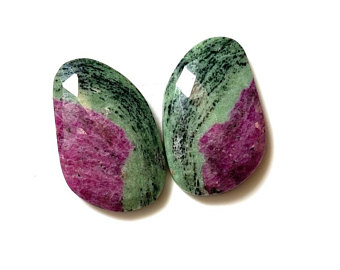
Thus, ruby zoisite is a brilliant green form of zoisite engraved with ruby crystals of a medium grade. The red rubies are usually erratically spread across the big green zoisite, making the stone a uniquely exquisite and enchanting piece.
The gemstone was named ruby zoisite by the Austrian naturalist as well as scientist, Aron Sigmund Zois von Edelstein[wiki]. However, it was an English prospector, Tom Blevins, who first found the stone while mining in Longido, a district in northeast Tanzania in 1954. This is also the place where another form of zoisite called tanzanite is widely mined.
Even today, the nation remains the only major source of this stone. In 1949, Blevins initially believed that he had discovered substantial ruby deposits but it then was found to be a green zoisite matrix having big inclusions of usually opaque ruby. The stone is also found heavily with black hornblende minerals.
For centuries, this gemstone is known as an ornamental piece. This is due to its mesmerizing combination of deep red ruby and green zoisite. The stone is believed to be among the most dazzling ornamental rocks.
Zoisite became a significant gemstone when a purplish-blue to transparent blue form of it was found. This form is now popular as Tanzanite, a primary form known today. Its other form is the pink-to-red type known as Thulite, an opaque and dense variety composed of tightly interlocking crystals.
The green opaque form was first found in 1954 and it typically has black amphibole veins or presences. It is usually associated with opaque ruby due to its distinctly matching color and is today known as ruby zoisite.
This gem is believed to reinforce psychic ability as well as spirituality. The ruby’s deep magenta red is believed to be the ‘King’, whereas its transparent green is considered the ‘Queen.’ The ancient users believed it to surpass all other valuable gemstones in terms of virtue. This is because it holds a vibration that generates an improved state of consciousness due to which the user can see not only one’s own self but also the universe.
Ruby zoisite features a great blend of energy and color due to which it is one of the most glorious as well as noblest stones. Due to the natural energies it possesses, the stone is worshiped in several civilizations across history.
As a genuinely spiritual stone, ruby zoisite has been frequently treated as a talisman of love. As a robust help for anyone, it is likely to have black and white patches along with some more colors for rekindling spirituality. Its crimson color stands for the sun and its shimmering hues indicate opulence as well as protection as an asset for the one who wears it.
Available at times in the hues of olive, the stone’s green color ranges from the darkest emerald to pale light green, which stunningly contrasts with the included ruby’s red color. The stone offers a beneficial influence on anything that originates and lasts.
The meditative color, green, is believed to help in interacting with the spirits. Further, its revitalizing qualities make the stone the most auspicious of all the green living beings. The energy of red color improves innovation and inspires a passion for life.
The distinct harmony of colors exposes the divine sense of bliss such that anyone can feel its accompanying enthusiasm for life. Due to the incredible combination of healing and magical energies, the stone has also been termed a light of the soul.
By uplifting one’s fortitude and inner strength, the stone is highly potent for the ones who are more inclined towards self-disregard, suppressed anger, and self-harm. It works by integrating the energy of high frequency and helping in comprehending the true richness of spirit.
The magical properties of the stone are known to kindle and augment psychic abilities due to which it has been widely used by Asian healers for diagnosing disorders and interacting with the natural spirits.
Properties
Physical Properties
Anyolite is a mix of ruby and zoisite and is formed naturally using crystallized heaps. These heaps are composed of ruby crystals and green zoisite.
Thus, the outcome is a mineral stone that has properties of calcium aluminum silicate, being generated from prismatic crystals and granular as well as giant columnar traits. Calcium is present in mica and aluminum in kaolin clay. Silica, too, is a critical mineral ingredient.

Ruby zoisite is a kind of zoisite having ruby crystals as a special inclusion. However, zoisite itself contains the mineral called calcium aluminum hydroxy sorosilicate, which is found in metamorphic, igneous, and sedimentary rocks.
While zoisite varies significantly in terms of color, zoisite in ruby zoisite is usually green. Still, its color combinations can vary from deep-red or black and greenish hue to red and leaf-green. Each color has its distinct meaning.
Ruby zoisite is an extraordinary form of zoisite and is an ornamental mineral featuring a crystalline collection of non-transparent ruby veins and green zoisite. The green zoisite is comparatively soft and its hardness scale rating is between 5.5 – 6.5 on the Mohs scale.
On the other hand, the ruby inclusions are hard with a rating of almost 9. Zoisite itself has a rating of 6.5 to 7, while its other forms have a hardness rating of 6. Zoisites can range from sub-translucent to transparent and are usually vitreous and brittle. This mineral has heaps of prismatic crystals and the crystal system is orthorhombic.
Metaphysical Properties
With zoisite as the base and ruby properties dispersed across the composition, the outcome is highly energetic properties that decay negativity and convert the negative fields into positive ones. The resulting energy allows positive forces to engulf the negativity and keep lethargy at bay.
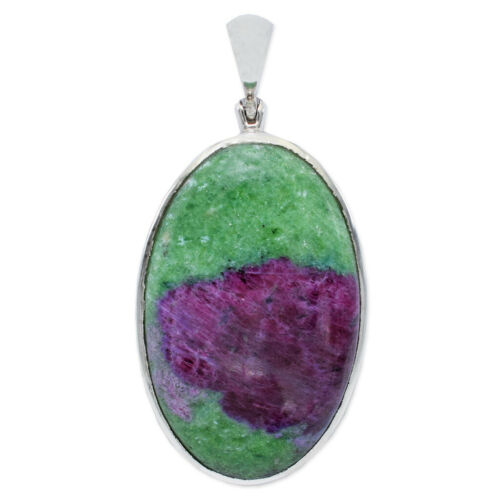
The ruby inclusions develop an energetic combination that aids to reach as well as sustain deep meditative states. This helps in stimulating the mind as well as increasing both mental and psychic aptitudes.
Due to this attribute, the stone can strengthen a full-body field. As a result, it reveals important healing properties. Thus, the stone is also believed to be useful for diagnosis in a variety of Asian therapeutic practices such as Ayurvedic.
While transmuting energies that are negative, the stone converts the destructive inclinations into constructive ones. Thus, it can prevent mood swings and help in bringing more mental clarity as well as better focus.
The stone is believed to improve the relationship between the brain and the heart. The heart and mind of the wearer truly find a way to function together and generate amazing outcomes. The stone can also enable communication between your spirit guide and you.
When positioned on the Crown chakra, the stone can heighten spirituality, involving the energy field of the body. This is one reason why it can prevent you from over-reacting in tough times.
The great harmony of its colors also signifies the spirit of happiness that is felt while relaxing and practicing the remedy to let go. Being heart-based, the stone is known to enhance positivity in love life. It also symbolizes vitality and growth. With it, you are also likely to attract wealth.
The ruby inclusions in zoisite are capable of calming the heart without compromising the body’s equilibrium, especially in stressful situations. They can also aid in relieving inflammation and increase strength in the heart, lungs, and immune system.
Ruby zoisite can also aid in healing disorders related to the reproductive organs. Thus, it helps in boosting fertility in both genders. It also aids the wearer in retaining individuality and connection with others.
Where to Buy Ruby Zoisite?
Usually Etsy or Amazon is a good idea. Etsy is the leading online global marketplace of handmade, vintage, and creative goods. Amazon is one of the largest global online marketplaces. Both of them are reliable and easy to find your favorite items there.
Ruby Zoisite in Jewelry Uses
The ruby zoisite stone amalgamates a vibrant and stunning pageant of energy and life force spirits due to which it is a promising showpiece when it comes to jewelry. Its lively energy makes it a preferred gemstone for necklaces, earrings, pendants, and head accessories for feeling the positivity vibrations the stone sends to the brain. When positioned in bracelets and rings, the same can be felt for the heart.
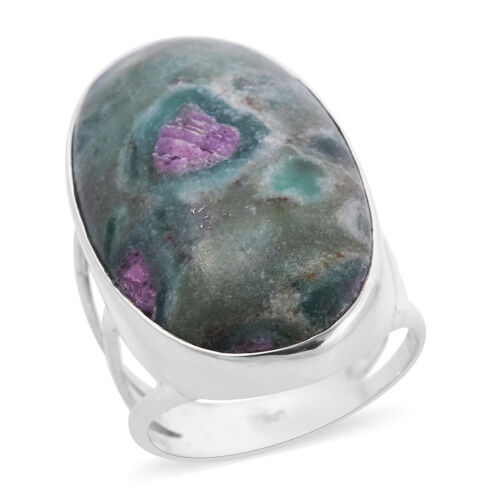
Available commercially as loose stones or as a jewelry showpiece, the stone is admired for its rich red and green combinations. Usually shaped into pendants and figurines, there is no dearth of ornamental pieces made using this stone.
The wildly varied color combinations and different shapes are such that they make your jewelry look distinct. Meticulously crafted, jewelry pieces of ruby zoisite can truly be one of a kind. Many of them are made using the premium 925 sterling silver such that no two pieces seem alike.
While silver is commonly used with it, gold-hued metals give an additional touch of archaic charm to the different jewelry items. Ruby zoisite jewelry is usually artistic and is ideal for a casual or boho getup.
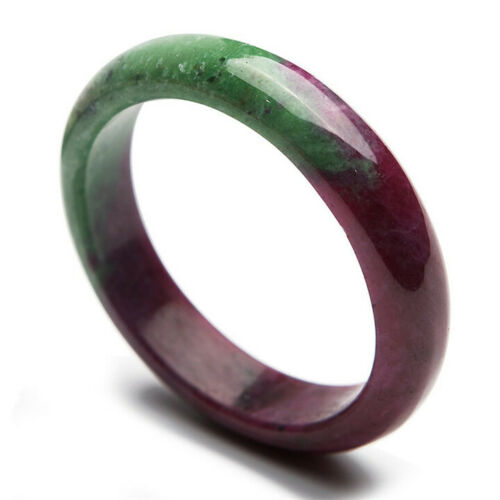
Ruby zoisite is usually shaped into cabochons and beads just like any other opaque gemstone. Nevertheless, when faceted, it takes in additional depth and texture to deliver augmented beauty.
The stone is also widely used as superb material for carving small figurines, ornamental showpieces, and statues. This is because it is easy to cut it. The stone is usually polished and then used in making ornamental pieces or jewelry. Due to its opaque nature, the stone is not that widely utilized in high-end jewelry. It is often confined to ornamentation pieces and artisan jewelry items.
Above all, ruby zoisite is admired as an ornamental stone by those who want to experience its metaphysical properties. It is common to see it carved into ornate decorative items. At times, fine materials are likely to be faceted. Ruby zoisite’s beads that are drilled and tumbled are pretty popular. Of all, their big oval shapes are famous.
As this stone is not so hard, it is typically positioned in halo or bezel settings. Here, they play the role of a buffer and prevent the stone’s edges from being damaged. The stone also goes well with other ornaments such as pearl earrings. The stone is also used as bookends or small ornamental bowls.
Where Does Ruby Zoisite Come From?
The gemstone occurs in locally metamorphosed crystalline schists formed due to the presence of igneous, metamorphic, and sedimentary rocks that are rich in calcium. These rocks are widely present on the rocky ridges of the region surrounding Tanzania’s Mount Kilimanjaro and in the Zambia country of the African sub-continent.
The stone is also widely found in India. Today, India is the biggest manufacturer of this stunning gemstone.
How Much Is Ruby Zoisite Worth?
The stone is available in big pieces that are quite affordable. While cutting it, the cutters look for a big amount of ruby inclusions in the stone’s base, as it is these inclusions that result in red and pink hues that increase both the value and beauty of the stone.
Nevertheless, smart cutters are aware of the fact that it is not the number of ruby crystals that make the mineral so fascinating but the distinct patterns they make with the green base.
Thus, although varieties having more ruby crystals have a high value, the quality of each of them is relatively subjective. In other words, the value is dependent on how stunning the color patterns are.
Unlike tanzanite which is a form of zoisite, this stone is available in huge quantities due to which it is inexpensive. It is collected widely by several amateur and hobbyist designers of jewelry.
How to Identify Ruby Zoisite?
You can identify ruby zoisite by its characteristic speckled colors. Its typical for is primarily composed of huge veins of red ruby and black hornblende along with green zoisite to come up with interesting patterns.
You can even identify the stone by measuring its hardness on the Mohs scale. This should be around 6.5 to 7. It is also possible to identify it from its origin. Just as tanzanite, this stone is found in Tanzania and India, which is a clear distinguishing factor.
At times, you may think it to be chloromelanite. However, a genuine ruby zoisite will have more pink and red hues. Thus, you can identify the stone based on its color pattern: green due to zoisite, pink or red because of crystals of ruby, and occasional black because of the dark hornblende mineral present in it.
The black color is not always there. However, it is typically unfavorable unless it adds to a distinct and interesting pattern. Chloromelanite features a distinct shade of green. Rather than red or pink inclusions, there are black and dark green inclusions.
Usually, the ratio between red and green is likely to differ significantly as per the number of ruby crystals. At times, the stone is likely to be mostly green with only some pink or red spots. Similarly, it can also be mostly red and pink with a few green corners. However, the latter is a rare case, as green is more prevalent.
You can also apply the knowledge of other characteristics. For example, genuine ruby zoisites are opaque due to the inclusions. Further, it is likely to have a virtuous luster once it is polished. In short, a vibrant, smooth, and virtuous luster is what you should check for.
It is vital to note that this gemstone is not treated in any way for making enhancements. Thus, there is no need to bother about whether the stone you got is real or not.
How to Use Ruby Zoisite?
Jewelry pieces having this gemstone are available in most gemstone jewelry shops. The red and green contrast makes it a preferable choice for necklaces, bracelets, and pendants. Wearing it as a part of your jewelry will keep its positive vibes close to your body, uplift your aura, and magnify your energy fields.
Apart from jewelry, you can even feel the positive energy of this stone by keeping it in your purse or wallet.
How to Cleanse Ruby Zoisite?
The best way to cleanse this gemstone is to use a soft cloth and mild soapy water. Stronger detergents can hurt the stone over time. Further, just ensure to rinse well so that no soapy residue is left. To energize, you can simply place the stone in the full moon moonlight for a few hours. You can even move it through sage incense, put it in rice, or hide it beneath the earth throughout the night. Here are some more tips for keeping it energized or cleansing it wisely:
- Due to ideal cleavage, ruby zoisite cannot tolerate hard knocks or blows that can fracture or split it. So, you should protect it from them. For example, you should always remove your jewelry prior to exercising, indulging in sports, or performing energetic chores at home such as washing.
- The stone is a softer mineral than other famous jewelry gemstones such as topaz and sapphire. Thus, ensure that it is not exposed continuously to strong heat, sudden temperature fluctuations, and direct light. You should also not allow it to expose to acid and harsh chemicals such as those in cleaners.
- Avoid cleaning it with the help of steam and ultrasonic cleaners, as the strong vibrations can result in cracks.
- Keep this stone away from other stones to keep scratches at bay, as it is not that hard. It is ideal to put it in a soft cloth or a jewelry box lined with a piece of fabric. The underlying notion here is to keep them away from other jewelry types, as metals are harder enough to scratch the soft surface.
Ruby Zoisite vs. Ruby Fuchsite
It is true that ruby in zoisite or ruby zoisite is often believed to be ruby in fuchsite or ruby fuchsite due to the analogous look. However, they both are different gemstones. You can differentiate between the two through careful testing.
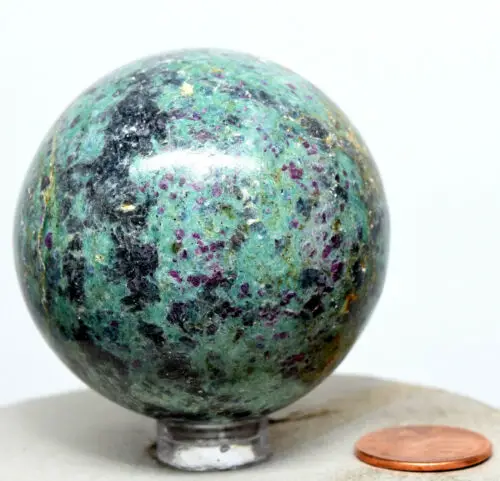
Green fuchsite rates 2 to 3 on the Mohs hardness scale, which is half of what ruby zoisite rates. Further, most varieties of ruby fuchsite show alternating rims of blue kyanite halo surrounding the ruby crystals. This is something that ruby crystals in zoisite never show.
Fuchsite is nothing but a bright green form of muscovite mica. This hue comes from chromium. It can range from light to emerald green as per the quantity of chromium. One of the best ways to identify ruby fuchsite is to check for white to cream hue around ruby, as it is pure muscovite having no chromium.
The Best Combination to Use With Ruby Zoisite
Ruby zoisite blends well with apophyllite or tanzanite, as their energies tend to complement in the best way. The stone also gels well with any type of sapphire. For increasing creativity, consider using ruby zoisite with cinnabar, sunstone, or sardonyx.
For activating chakras, it is ideal to combine Ruby Zoisite with pink tugtupite or tinaksite. If you use it with ruby, you will be ensured of more energy and vibrancy.
Final Words
Ruby zoisite is a stabilizing, detoxifying stone that can create an energetic aura, maintain trance states, uplift spirituality, and amplify psychic talents. Thus, it is highly beneficial to wear jewelry that is usually affordable.